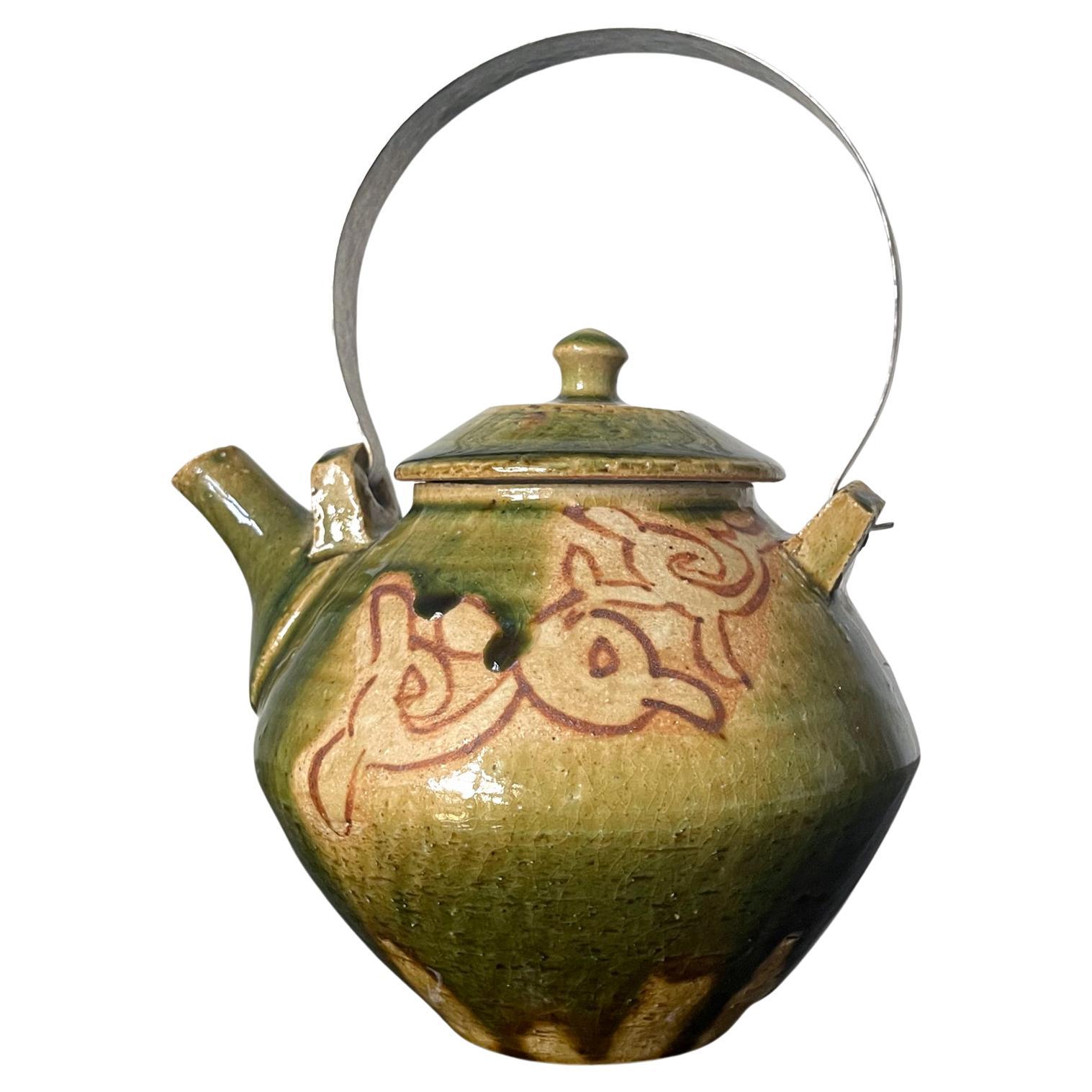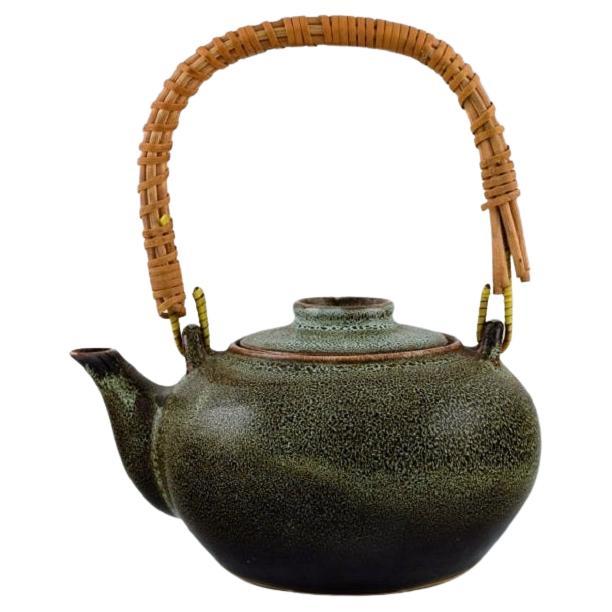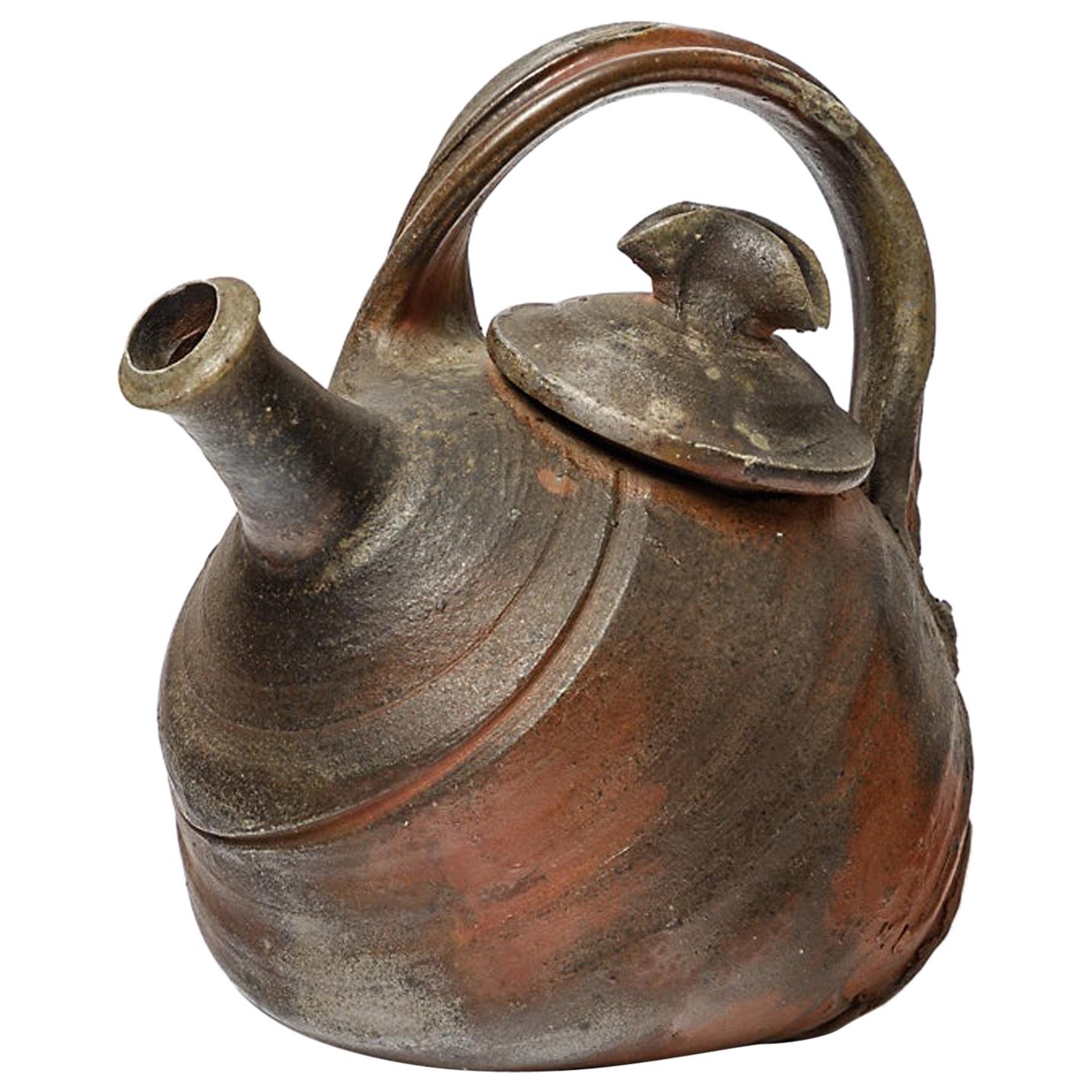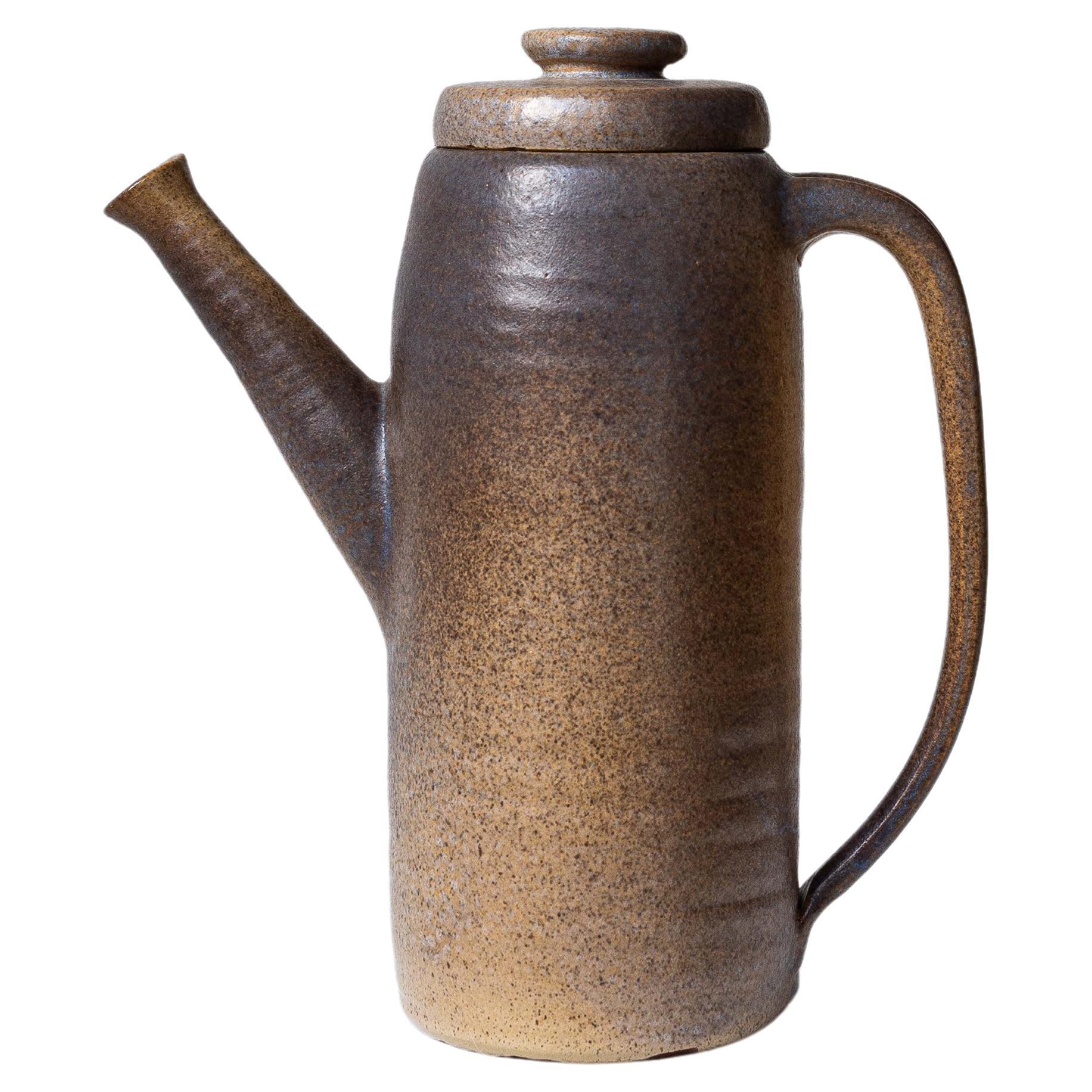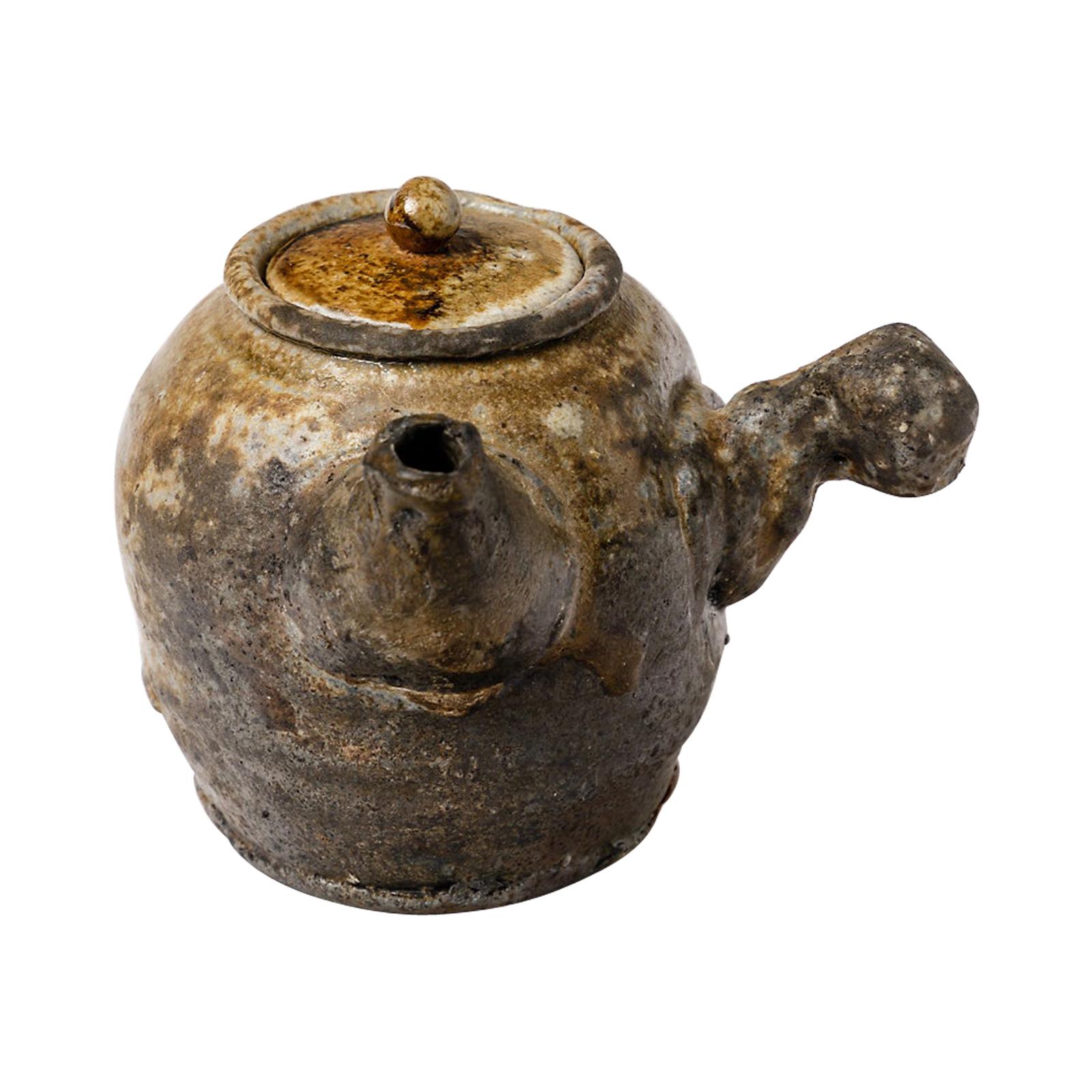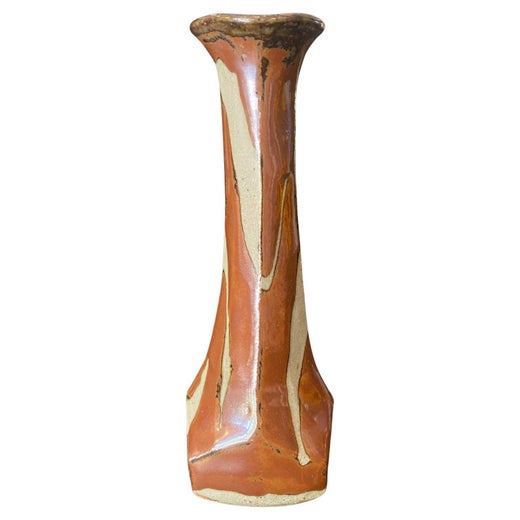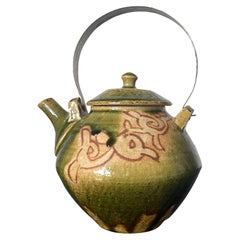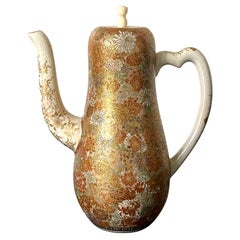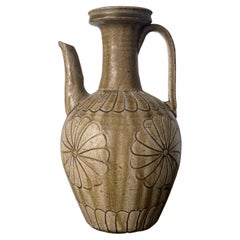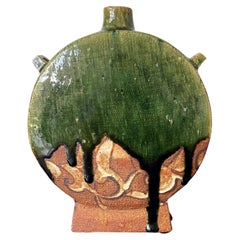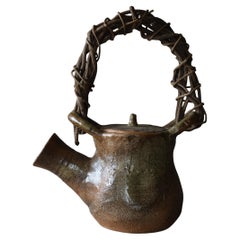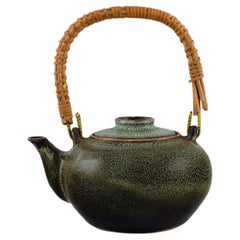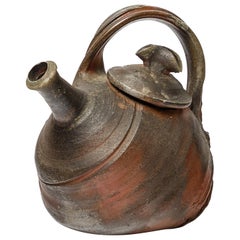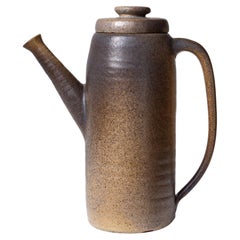Items Similar to Japanese Mingei Glazed Tea Pot with Kintsugi by Shoji Hamada
Want more images or videos?
Request additional images or videos from the seller
1 of 21
Japanese Mingei Glazed Tea Pot with Kintsugi by Shoji Hamada
$5,000
£3,793.88
€4,337.97
CA$6,983.64
A$7,764.86
CHF 4,054.38
MX$94,517.28
NOK 51,732.16
SEK 48,470.56
DKK 32,375.06
Shipping
Retrieving quote...The 1stDibs Promise:
Authenticity Guarantee,
Money-Back Guarantee,
24-Hour Cancellation
About the Item
A Japanese stoneware tea pot by Hamada Shoji (Japanese 1894-1978) circa 1960-80s. The teapot is of the classic form and of a strong style of Mingei (folk art(. It was covered in a thick Nuka glaze (ashes from husks of rice hulls) with prominent dripping effects to the lower unglazed body. The handle shows kintsugi repair which was done at some point of its life historically, adding a special charm to the piece. The teapot comes its original tomobako storage box with artist's signature and title as well as glaze name.
Japanese potter Hamada Shoji (1894-1978) was a leading figure of the Mingei (Folk Art) movement in Japan. He established his studio and practice in the Japanese town Mashiko to reinvent and spearhead the style that is both rustic and refined. From the renowned pottery center, he connected with international art communities by introducing the traditional Japanese pottery art to a wider world. In 1955 he was designated a "Living National Treasure", for the first time for someone from the field of crafts.
- Creator:Shoji Hamada (Artist)
- Dimensions:Height: 9 in (22.86 cm)Diameter: 9 in (22.86 cm)
- Style:Modern (Of the Period)
- Materials and Techniques:Ceramic,Glazed
- Place of Origin:
- Period:
- Date of Manufacture:20th Century
- Condition:Repaired: Kintsugi repairs on the handle. Wear consistent with age and use. The handle was historically repaired with Kingtshui as shown. Box shows minor wear.
- Seller Location:Atlanta, GA
- Reference Number:1stDibs: LU945028780762
Shoji Hamada
Shoji Hamada, Designated as a Living National Treasure in 1955, was famed for his return to folk crafts (mingei), establishing the small town of Mashiko as a center of pottery. Hamada espoused simplicity of form in his works, particularly notable in his sugar cane motifs. Hamada strived to reach a style and feeling of innocence through his craft.
About the Seller
4.9
Platinum Seller
Premium sellers with a 4.7+ rating and 24-hour response times
Established in 2006
1stDibs seller since 2010
564 sales on 1stDibs
Typical response time: <1 hour
- ShippingRetrieving quote...Shipping from: Atlanta, GA
- Return Policy
Authenticity Guarantee
In the unlikely event there’s an issue with an item’s authenticity, contact us within 1 year for a full refund. DetailsMoney-Back Guarantee
If your item is not as described, is damaged in transit, or does not arrive, contact us within 7 days for a full refund. Details24-Hour Cancellation
You have a 24-hour grace period in which to reconsider your purchase, with no questions asked.Vetted Professional Sellers
Our world-class sellers must adhere to strict standards for service and quality, maintaining the integrity of our listings.Price-Match Guarantee
If you find that a seller listed the same item for a lower price elsewhere, we’ll match it.Trusted Global Delivery
Our best-in-class carrier network provides specialized shipping options worldwide, including custom delivery.More From This Seller
View AllModern Japanese Studio Pottery Oribe Tea Pot by Ken Matsuzaki
By Ken Matsuzaki
Located in Atlanta, GA
A contemporary studio ceramic tea pot with metal handle made by Japanese potter Ken Matsuzaki (1950-). The stoneware tea pot showcases a thick dripping Oribe green glaze partially revealing the unglazed part of the body, which is decorated with scrolling pattern of ash glaze. The work is rooted in both Yohen Shino glaze technique and Oribe tradition, but interestingly it also paid homage to Sancai pottery...
Category
Early 2000s Japanese Modern Ceramics
Materials
Ceramic
Japanese Satsuma Ceramic Ewer Yabu Meizan
By Yabu Meizan
Located in Atlanta, GA
A Satsuma ware miniature ewer from the studio of Yabu Meizan (birth name Yabu Masashichi; 1853-1934), who was one of the most celebrated and collectible Satsuma artists from the Meij...
Category
Early 20th Century Japanese Japonisme Ceramics
Materials
Ceramic
Japanese Ko-Seto Stoneware Ewer with Carved Design
Located in Atlanta, GA
On offer is a rare Ko-seto (old seto) stoneware ewer from Kamakura period (12-14th century) Japan. The exceptionally heavily potted ewer is made of stoneware. The main body was likely hand-coiled with individually built handle, sprout and wheel-made neck and mouth assembled. It takes the basic form from the contemporary Chinese ewer...
Category
Antique 15th Century and Earlier Japanese Archaistic Ceramics
Materials
Stoneware
Modern Japanese Studio Pottery Oribe Moon Flask Vase by Ken Matsuzaki
By Ken Matsuzaki
Located in Atlanta, GA
A contemporary studio ceramic vase made by Japanese potter Ken Matsuzaki (1950-). The vase showcases distinguished "moon flask" form with shoulder loops. The moon flask form was widely recorded first in Tang Dynasty China, most likely arrived from the Mideast countries via the silk road. It was originally used as drink vessel for the nomads and the loops were used to tie it to the horse-centered owner. The exotic form persisted in Chinese ceramic production through Ming to Qing dynasty. The form is unusual in Ken Matsuzaki's work. The artist covered the vase with a thick dripping Oribe green glaze partially revealing the unglazed part of the body, which is decorated with scrolling pattern in left by ash glaze. The work is rooted in both Yohen Shino glaze technique and Oribe tradition, but interestingly it also paid homage to Sancai pottery in Tang Dynasty when green glaze was prominently used to drip and splash onto the pottery. Viewing the vase, one can see in this harmonious piece, the innovative reinterpretation of ancient aesthetics that cross the cultures, geology and time. The base is marked with the artist's signature. The vase comes with an inscribed tomobako storage box with the artist's bio and wrapping cloth with seal. The vase measures 8.6"h x 7"w x 2"d.
Ken Matsuzaki’s haptic ceramics bring a contemporary approach to traditional Japanese ceramicware, most notably 16th-century Oribe pottery...
Category
Early 2000s Japanese Modern Ceramics
Materials
Ceramic
Japanese Antique Ewer Lacquer with Bronze Edo to Meiji Period
Located in Atlanta, GA
A Japanese lacquer water ewer without handle (known as hazo in Japanese) that was used to carry water, traditionally together with a large basin (known as tsunodarai) for domestic us...
Category
Antique 19th Century Japanese Japonisme Lacquer
Materials
Bronze
Ceramic Vase with Bespoken Glaze by Makoto Yabe
By Makoto Yabe
Located in Atlanta, GA
Made by Japanese ceramic artist Makoto Yabe (1947-2005), this stoneware vase features a globular body supported by a round pedestal foot. A similarly shaped neck extends to a rimmed mouth opening. Robust in form with thick wall, the vase is noted for its irregular cloved form. The surface is covered in a beige-yellow glaze, on top of which, dark brown strokes and thick white feldspar slip were artistically applied in a splashed and washed pattern. Together with some random shallow incision lines, they form an abstract painting with textured surface where some slip forms small droplets at the end of the stroke. The work was created in traditional Japanese manner and reflects the beauty of Wabi Sabi, a Zen aesthetic for the imperfect perfection.
The base was incised with the artist's cipher.
"Makoto Yabe's work beautifully exemplifies the transmission of Japanese ceramics to the West. Born in Fukushima, Japan, Yabe began studying ceramics in Kyoto at the age of nine. He completed his training at the age of 24, with a four-year apprenticeship under Jinmatsu Uno and Sango Uno. Yabe then came to Boston, where he was an integral member of the local ceramic community, yet he maintained his Japanese roots. As an instructor of ceramics, Yabe worked in the Boston area at numerous schools and universities, touching the lives of all his students and expanding their knowledge and appreciation of studio ceramics."
Biography sited from Pucker Gallery...
Category
Late 20th Century American Organic Modern Ceramics
Materials
Ceramic, Stoneware
You May Also Like
Extra-Large Japanese Mingei Shigaraki Dobin Pottery Tea Pot
Located in Chiba, JP
Extra-large high-fired unglazed Shigaraki stoneware dobin tea-pot with such a wild vine handle, Showa period, 20th century, Japan, approx. H 44 x 35 x 19cm (17.32 x 13.77 x 7.48in)
Category
Mid-20th Century Japanese Japonisme Ceramics
Materials
Ceramic
Chinese Teapot in Glazed Stoneware with Wicker Handle, 20th C
Located in København, Copenhagen
Chinese teapot in glazed stoneware with wicker handle.
Beautiful speckled glaze in dark green and turquoise shades. 20th Century.
Measures: 17.5 x 16 cm (incl. Handle).
In excell...
Category
20th Century Chinese Tableware
Materials
Stoneware, Wicker
Brown Wood-Firing Ceramic Tea Pot by Jo Miquel 1993 mid-century French Design
Located in Neuilly-en- sancerre, FR
Josette Miquel
Elegant brown stoneware ceramic tea pot
Original perfect conditions
Signed under the base
Brown woodfiring ceramic effects an...
Category
20th Century French Mid-Century Modern Tea Sets
Materials
Ceramic
Handmade Ceramic Teapot in Brown Enamel France 1970s
By Jean Lerat, Robert Deblander, La Borne Potters, Claude Champy
Located in ROUEN, Normandie
Handmade Ceramic Teapot in Brown Enamel France 1970s
This vintage ceramic teapot was handmade by french artist Bernard Defer or Maxime Defer (h...
Category
Mid-20th Century French Mid-Century Modern Tea Sets
Materials
Sandstone
Korean Stoneware Ceramic Tea-Pot by Seung Ho Yang Korea and La Borne Artist
Located in Neuilly-en- sancerre, FR
Seung ho Yang
Rare stoneware ceramic tea-pot by Seugn ho Yang, realised in La Borne, France.
Beautiful fire kiln stoneware ceramic effects.
Signed under the base
circa 19...
Category
Late 20th Century French Mid-Century Modern Tea Sets
Materials
Pottery
Korean, Joseon Dynasty Brown Green Glazed Stoneware Pottery Ceramic Teapot
Located in Studio City, CA
A wonderfully crafted Korean stoneware pottery teapot with a beautiful muted green and brown glaze, color, and nicely aged patina. This work radiates ...
Category
Antique 19th Century Korean Ceramics
Materials
Stoneware
